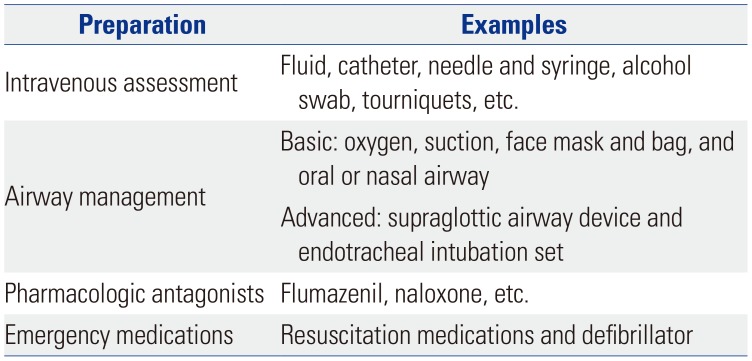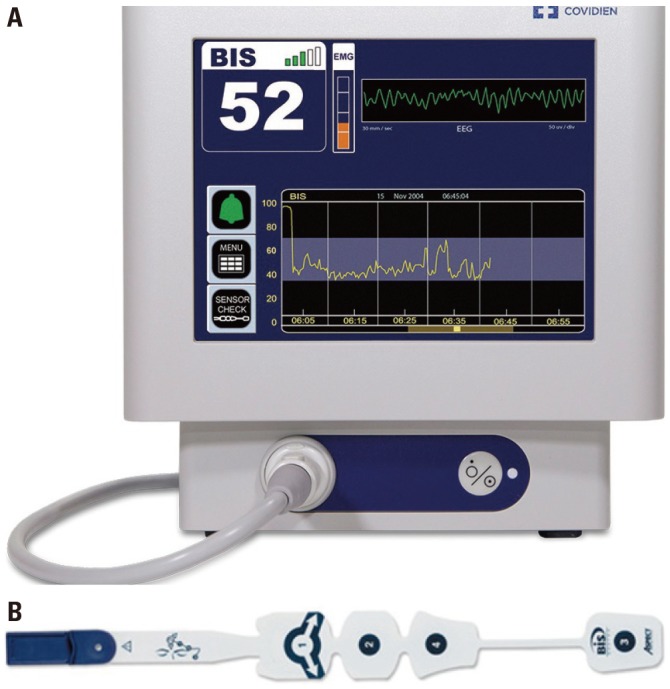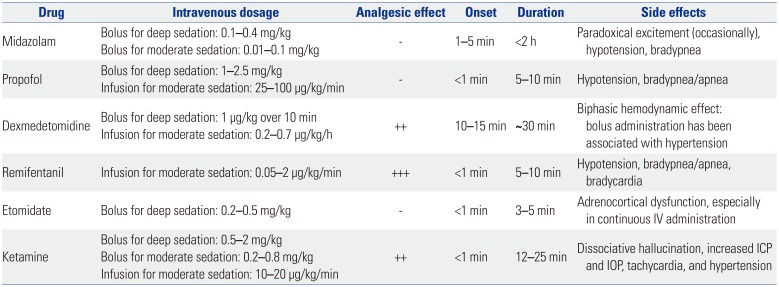1. Practice Guidelines for Moderate Procedural Sedation and Analgesia 2018: a report by the American Society of Anesthesiologists Task Force on Moderate Procedural Sedation and Analgesia, the American Association of Oral and Maxillofacial Surgeons, American College of Radiology, American Dental Association, American Society of Dentist Anesthesiologists, and Society of Interventional Radiology. Anesthesiology. 2018; 128:437–479. PMID:
29334501.
2. Pino RM. The nature of anesthesia and procedural sedation outside of the operating room. Curr Opin Anaesthesiol. 2007; 20:347–351. PMID:
17620844.

3. Cravero JP, Beach ML, Blike GT, Gallagher SM, Hertzog JH. Pediatric Sedation Research Consortium. The incidence and nature of adverse events during pediatric sedation/anesthesia with propofol for procedures outside the operating room: a report from the Pediatric Sedation Research Consortium. Anesth Analg. 2009; 108:795–804. PMID:
19224786.

4. Michel Foehn ER. Adult and pediatric anesthesia/sedation for gastrointestinal procedures outside of the operating room. Curr Opin Anaesthesiol. 2015; 28:469–477. PMID:
26087269.
5. Youn AM, Ko YK, Kim YH. Anesthesia and sedation outside of the operating room. Korean J Anesthesiol. 2015; 68:323–331. PMID:
26257843.

6. Gozal D, Gozal Y. Pediatric sedation/anesthesia outside the operating room. Curr Opin Anaesthesiol. 2008; 21:494–498. PMID:
18660660.

7. Bell A, Treston G, McNabb C, Monypenny K, Cardwell R. Profiling adverse respiratory events and vomiting when using propofol for emergency department procedural sedation. Emerg Med Australas. 2007; 19:405–410. PMID:
17919212.

8. Agrawal D, Manzi SF, Gupta R, Krauss B. Preprocedural fasting state and adverse events in children undergoing procedural sedation and analgesia in a pediatric emergency department. Ann Emerg Med. 2003; 42:636–646. PMID:
14581915.

9. Godwin SA, Burton JH, Gerardo CJ, Hatten BW, Mace SE, Silvers SM, et al. Clinical policy: procedural sedation and analgesia in the emergency department. Ann Emerg Med. 2014; 63:247–258. PMID:
24438649.

10. Van De Velde M, Kuypers M, Teunkens A, Devroe S. Risk and safety of anesthesia outside the operating room. Minerva Anestesiol. 2009; 75:345–348. PMID:
19412156.
11. Bhananker SM, Posner KL, Cheney FW, Caplan RA, Lee LA, Domino KB. Injury and liability associated with monitored anesthesia care: a closed claims analysis. Anesthesiology. 2006; 104:228–234. PMID:
16436839.
12. Choi JW, Kim DK, Cho CK, Park SJ, Son YH. Trends in medical disputes involving anesthesia during July 2009-June 2018: an analysis of the Korean Society of Anesthesiologists database. Korean J Anesthesiol. 2019; 72:156–163. PMID:
30301317.
13. Metzner J, Domino KB. Risks of anesthesia or sedation outside the operating room: the role of the anesthesia care provider. Curr Opin Anaesthesiol. 2010; 23:523–531. PMID:
20531171.

14. Cacho G, Pérez-Calle JL, Barbado A, Lledó JL, Ojea R, Fernández-Rodríguez CM. Capnography is superior to pulse oximetry for the detection of respiratory depression during colonoscopy. Rev Esp Enferm Dig. 2010; 102:86–89. PMID:
20361844.

15. Qadeer MA, Vargo JJ, Dumot JA, Lopez R, Trolli PA, Stevens T, et al. Capnographic monitoring of respiratory activity improves safety of sedation for endoscopic cholangiopancreatography and ultrasonography. Gastroenterology. 2009; 136:1568–1576. PMID:
19422079.

16. Waring JP, Baron TH, Hirota WK, Goldstein JL, Jacobson BC, Leighton JA, et al. American Society for Gastrointestinal Endoscopy, Standards of Practice Committee. Guidelines for conscious sedation and monitoring during gastrointestinal endoscopy. Gastrointest Endosc. 2003; 58:317–322. PMID:
14528201.

19. Hinkelbein J, Lamperti M, Akeson J, Santos J, Costa J, De Robertis E, et al. European Society of Anaesthesiology and European Board of Anaesthesiology guidelines for procedural sedation and analgesia in adults. Eur J Anaesthesiol. 2018; 35:6–24. PMID:
28877145.

22. Weaver CS, Hauter WH, Duncan CE, Brizendine EJ, Cordell WH. An assessment of the association of bispectral index with 2 clinical sedation scales for monitoring depth of procedural sedation. Am J Emerg Med. 2007; 25:918–924. PMID:
17920977.

23. Fruchter O, Tirosh M, Carmi U, Rosengarten D, Kramer MR. Prospective randomized trial of bispectral index monitoring of sedation depth during flexible bronchoscopy. Respiration. 2014; 87:388–393. PMID:
24602973.

24. Yang KS, Habib AS, Lu M, Branch MS, Muir H, Manberg P, et al. A prospective evaluation of the incidence of adverse events in nurse-administered moderate sedation guided by sedation scores or Bispectral Index. Anesth Analg. 2014; 119:43–48. PMID:
24413547.

25. Paspatis GA, Chainaki I, Manolaraki MM, Vardas E, Theodoropoulou A, Tribonias G, et al. Efficacy of bispectral index monitoring as an adjunct to propofol deep sedation for ERCP: a randomized controlled trial. Endoscopy. 2009; 41:1046–1051. PMID:
19967620.

26. von Delius S, Salletmaier H, Meining A, Wagenpfeil S, Saur D, Bajbouj M, et al. Bispectral index monitoring of midazolam and propofol sedation during endoscopic retrograde cholangiopancreatography: a randomized clinical trial (the EndoBIS study). Endoscopy. 2012; 44:258–264. PMID:
22261747.

27. Analgesic agents. In : Butterworth JF, Mackey DC, Wasnick JD, editors. Clinical anesthesiology. 6th ed. New York: McGraw-Hill Education;2018. p. 187–197.
28. Intravenous anesthetics. In : Butterworth JF, Mackey DC, Wasnick JD, editors. Clinical anesthesiology. 6th ed. New York: McGraw-Hill Education;2018. p. 171–185.
29. Intravenous anesthetics. In : Morgan JF, Mackey DC, Wasnick JD, editors. Morgan & Mikhail's clinical anesthesiology. 6th ed. New York: McGraw-Hill Education;2018. p. 324–362.
31. Cohen LB, Delegge MH, Aisenberg J, Brill JV, Inadomi JM, Kochman ML, et al. AGA Institute. AGA Institute review of endoscopic sedation. Gastroenterology. 2007; 133:675–701. PMID:
17681185.

36. Forster A, Gardaz JP, Suter PM, Gemperle M. Respiratory depression by midazolam and diazepam. Anesthesiology. 1980; 53:494–497. PMID:
7457966.

37. Golparvar M, Saghaei M, Sajedi P, Razavi SS. Paradoxical reaction following intravenous midazolam premedication in pediatric patients - a randomized placebo controlled trial of ketamine for rapid tranquilization. Paediatr Anaesth. 2004; 14:924–930. PMID:
15500492.

38. Mancuso CE, Tanzi MG, Gabay M. Paradoxical reactions to benzodiazepines: literature review and treatment options. Pharmacotherapy. 2004; 24:1177–1185. PMID:
15460178.

39. Khan LC, Lustik SJ. Treatment of a paradoxical reaction to midazolam with haloperidol. Anesth Analg. 1997; 85:213–215. PMID:
9212150.

40. Jackson BF, Beck LA, Losek JD. Successful flumazenil reversal of paradoxical reaction to midazolam in a child. J Emerg Med. 2015; 48:e67–e72. PMID:
25497845.

41. Bryson HM, Fulton BR, Faulds D. Propofol. An update of its use in anaesthesia and conscious sedation. Drugs. 1995; 50:513–559. PMID:
8521772.
42. Machata AM, Willschke H, Kabon B, Kettner SC, Marhofer P. Propofol-based sedation regimen for infants and children undergoing ambulatory magnetic resonance imaging. Br J Anaesth. 2008; 101:239–243. PMID:
18534971.

43. Na SH, Song Y, Kim SY, Byon HJ, Jung HH, Han DW. A simulation study of propofol effect-site concentration for appropriate sedation in pediatric patients undergoing brain MRI: pharmacodynamic analysis. Yonsei Med J. 2017; 58:1216–1221. PMID:
29047247.

44. Yan JW, McLeod SL, Iansavitchene A. ketamine-propofol versus propofol alone for procedural sedation in the emergency department: a systematic review and meta-analysis. Acad Emerg Med. 2015; 22:1003–1013. PMID:
26292077.

45. Brechmann T, Maier C, Kaisler M, Vollert J, Schmiegel W, Pak S, et al. Propofol sedation during gastrointestinal endoscopy arouses euphoria in a large subset of patients. United European Gastroenterol J. 2018; 6:536–546.

46. Mamiya H, Noma T, Fukuda K, Kasahara M, Ichinohe T, Kaneko Y. Pain following intravenous administration of sedative agents: a comparison of propofol with three benzodiazepines. Anesth Prog. 1998; 45:18–21. PMID:
9790005.
47. Youn AM, Hsu TM. Heated carrier fluids in decreasing propofol injection pain: a randomized, controlled trial. Korean J Anesthesiol. 2017; 70:33–38. PMID:
28184264.

50. Bennett SN, McNeil MM, Bland LA, Arduino MJ, Villarino ME, Perrotta DM, et al. Postoperative infections traced to contamination of an intravenous anesthetic, propofol. N Engl J Med. 1995; 333:147–154. PMID:
7791816.

51. Michel-Macías C, Morales-Barquet DA, Reyes-Palomino AM, Machuca-Vaca JA, Orozco-Guillén A. Single dose of propofol causing propofol infusion syndrome in a newborn. Oxf Med Case Reports. 2018; 2018:omy023. PMID:
29942532.

53. Gertler R, Brown HC, Mitchell DH, Silvius EN. Dexmedetomidine: a novel sedative-analgesic agent. Proc (Bayl Univ Med Cent). 2001; 14:13–21. PMID:
16369581.

54. Kang D, Lim C, Shim DJ, Kim H, Kim JW, Chung HJ, et al. The correlation of heart rate between natural sleep and dexmedetomidine sedation. Korean J Anesthesiol. 2019; 72:164–168. PMID:
30481949.

55. Chen K, Lu Z, Xin YC, Cai Y, Chen Y, Pan SM. Alpha-2 agonists for long-term sedation during mechanical ventilation in critically ill patients. Cochrane Database Syst Rev. 2015; 1:CD010269. PMID:
25879090.

56. Oshima H, Nakamura M, Watanabe O, Yamamura T, Funasaka K, Ohno E, et al. Dexmedetomidine provides less body motion and respiratory depression during sedation in double-balloon enteroscopy than midazolam. SAGE Open Med. 2017; 5:2050312117729920. PMID:
28904794.

57. Cho JS, Shim JK, Na S, Park I, Kwak YL. Improved sedation with dexmedetomidine-remifentanil compared with midazolam-remifentanil during catheter ablation of atrial fibrillation: a randomized, controlled trial. Europace. 2014; 16:1000–1006. PMID:
24381332.

58. Paris A, Tonner PH. Dexmedetomidine in anaesthesia. Curr Opin Anaesthesiol. 2005; 18:412–418. PMID:
16534267.

59. Giovannitti JA Jr, Thoms SM, Crawford JJ. Alpha-2 adrenergic receptor agonists: a review of current clinical applications. Anesth Prog. 2015; 62:31–39. PMID:
25849473.

60. Ahmed SS, Unland T, Slaven JE, Nitu ME, Rigby MR. Successful use of intravenous dexmedetomidine for magnetic resonance imaging sedation in autistic children. South Med J. 2014; 107:559–564. PMID:
25188619.

61. Singh SA, Prakash K, Sharma S, Dhakate G, Bhatia V. Comparison of propofol alone and in combination with ketamine or fentanyl for sedation in endoscopic ultrasonography. Korean J Anesthesiol. 2018; 71:43–47. PMID:
29441174.

62. Litman RS. Conscious sedation with remifentanil during painful medical procedures. J Pain Symptom Manage. 2000; 19:468–471. PMID:
10908827.

63. Hohl CM, Kelly-Smith CH, Yeung TC, Sweet DD, Doyle-Waters MM, Schulzer M. The effect of a bolus dose of etomidate on cortisol levels, mortality, and health services utilization: a systematic review. Ann Emerg Med. 2010; 56:105–113. PMID:
20346542.

64. Vinson DR, Bradbury DR. Etomidate for procedural sedation in emergency medicine. Ann Emerg Med. 2002; 39:592–598. PMID:
12023700.

65. Sivilotti ML, Filbin MR, Murray HE, Slasor P, Walls RM. NEAR Investigators. Does the sedative agent facilitate emergency rapid sequence intubation? Acad Emerg Med. 2003; 10:612–620. PMID:
12782521.

66. Wagner RL, White PF. Etomidate inhibits adrenocortical function in surgical patients. Anesthesiology. 1984; 61:647–651. PMID:
6095700.

67. Owen H, Spence AA. Etomidate. Br J Anaesth. 1984; 56:555–557. PMID:
6721965.

68. Craven R. Ketamine. Anaesthesia. 2007; 62(Suppl 1):48–53. PMID:
17937714.

69. Christ G, Mundigler G, Merhaut C, Zehetgruber M, Kratochwill C, Heinz G, et al. Adverse cardiovascular effects of ketamine infusion in patients with catecholamine-dependent heart failure. Anaesth Intensive Care. 1997; 25:255–259. PMID:
9209606.

70. Gorlin AW, Rosenfeld DM, Ramakrishna H. Intravenous sub-anesthetic ketamine for perioperative analgesia. J Anaesthesiol Clin Pharmacol. 2016; 32:160–167. PMID:
27275042.

71. Gromski M, Matthes K. Gastrointestinal endoscopy procedures. In : Urman R, Gross WL, Philip B, editors. Anesthesia outside the operating room. 1st ed. New York: Oxford University Press;2011. p. 151–166.
72. Park CH, Shin S, Lee SK, Lee H, Lee YC, Park JC, et al. Assessing the stability and safety of procedure during endoscopic submucosal dissection according to sedation methods: a randomized trial. PLoS One. 2015; 10:e0120529. PMID:
25803441.

73. Thomson A, Andrew G, Jones DB. Optimal sedation for gastrointestinal endoscopy: review and recommendations. J Gastroenterol Hepatol. 2010; 25:469–478. PMID:
20370725.

74. Park CH, Min JH, Yoo YC, Kim H, Joh DH, Jo JH, et al. Sedation methods can determine performance of endoscopic submucosal dissection in patients with gastric neoplasia. Surg Endosc. 2013; 27:2760–2767. PMID:
23389074.

75. Lu Z, Li W, Chen H, Qian Y. Efficacy of a dexmedetomidine-remifentanil combination compared with a midazolam-remifentanil combination for conscious sedation during therapeutic endoscopic retrograde cholangio-pancreatography: a prospective, randomized, single-blinded preliminary trial. Dig Dis Sci. 2018; 63:1633–1640. PMID:
29594976.

76. Inatomi O, Imai T, Fujimoto T, Takahashi K, Yokota Y, Yamashita N, et al. Dexmedetomidine is safe and reduces the additional dose of midazolam for sedation during endoscopic retrograde cholangiopancreatography in very elderly patients. BMC Gastroenterol. 2018; 18:166. PMID:
30400828.

77. Schulte-Uentrop L, Goepfert MS. Anaesthesia or sedation for MRI in children. Curr Opin Anaesthesiol. 2010; 23:513–517. PMID:
20531170.

78. Heard C, Burrows F, Johnson K, Joshi P, Houck J, Lerman J. A comparison of dexmedetomidine-midazolam with propofol for maintenance of anesthesia in children undergoing magnetic resonance imaging. Anesth Analg. 2008; 107:1832–1839. PMID:
19020127.

79. Elmorsy SA, Soliman GF, Rashed LA, Elgendy H. Dexmedetomidine and propofol sedation requirements in an autistic rat model. Korean J Anesthesiol. 2019; 72:169–177. PMID:
29843508.

80. Griessenauer CJ, Shallwani H, Adeeb N, Gupta R, Rangel-Castilla L, Siddiqui AH, et al. Conscious sedation versus general anesthesia for the treatment of cerebral aneurysms with flow diversion: a matched cohort study. World Neurosurg. 2017; 102:1–5. PMID:
28279774.

81. Takeshita H, Okuda Y, Sari A. The effects of ketamine on cerebral circulation and metabolism in man. Anesthesiology. 1972; 36:69–75. PMID:
5006989.

82. Laskowski K, Stirling A, McKay WP, Lim HJ. A systematic review of intravenous ketamine for postoperative analgesia. Can J Anaesth. 2011; 58:911–923. PMID:
21773855.

83. Furniss SS, Sneyd JR. Safe sedation in modern cardiological practice. Heart. 2015; 101:1526–1530. PMID:
26085525.

84. Sairaku A, Yoshida Y, Hirayama H, Nakano Y, Ando M, Kihara Y. Procedural sedation with dexmedetomidine during ablation of atrial fibrillation: a randomized controlled trial. Europace. 2014; 16:994–999. PMID:
24351886.








 PDF
PDF ePub
ePub Citation
Citation Print
Print



 XML Download
XML Download